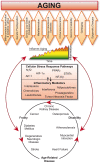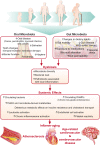Inflamm-ageing: the role of inflammation in age-dependent cardiovascular disease
- PMID: 32006431
- PMCID: PMC7453832
- DOI: 10.1093/eurheartj/ehz961
Inflamm-ageing: the role of inflammation in age-dependent cardiovascular disease
Abstract
The ongoing worldwide increase in life expectancy portends a rising prevalence of age-related cardiovascular (CV) diseases in the coming decades that demands a deeper understanding of their molecular mechanisms. Inflammation has recently emerged as an important contributor for CV disease development. Indeed, a state of chronic sterile low-grade inflammation characterizes older organisms (also known as inflamm-ageing) and participates pivotally in the development of frailty, disability, and most chronic degenerative diseases including age-related CV and cerebrovascular afflictions. Due to chronic activation of inflammasomes and to reduced endogenous anti-inflammatory mechanisms, inflamm-ageing contributes to the activation of leucocytes, endothelial, and vascular smooth muscle cells, thus accelerating vascular ageing and atherosclerosis. Furthermore, inflamm-ageing promotes the development of catastrophic athero-thrombotic complications by enhancing platelet reactivity and predisposing to plaque rupture and erosion. Thus, inflamm-ageing and its contributors or molecular mediators might furnish targets for novel therapeutic strategies that could promote healthy ageing and conserve resources for health care systems worldwide. Here, we discuss recent findings in the pathophysiology of inflamm-ageing, the impact of these processes on the development of age-related CV diseases, results from clinical trials targeting its components and the potential implementation of these advances into daily clinical practice.
Keywords: Cardiovascular disease; Endothelial dysfunction; Inflamm-ageing; Inflammation; Vascular ageing.
Published on behalf of the European Society of Cardiology. All rights reserved. © The Author(s) 2020. For permissions, please email: journals.permissions@oup.com.
Figures


Comment in
-
Inflamm-aging and obstructive sleep apnoea: a reciprocal relationship.Eur Heart J. 2020 Jul 7;41(26):2504. doi: 10.1093/eurheartj/ehaa334. Eur Heart J. 2020. PMID: 32385491 No abstract available.
-
Obstructive sleep apnoea and inflammation in age-dependent cardiovascular disease.Eur Heart J. 2020 Jul 7;41(26):2503. doi: 10.1093/eurheartj/ehaa332. Eur Heart J. 2020. PMID: 32385494 No abstract available.
References
-
- Camici GG, Savarese G, Akhmedov A, Luscher TF.. Molecular mechanism of endothelial and vascular aging: implications for cardiovascular disease. Eur Heart J 2015;36:3392–3403. - PubMed
-
- Paneni F, Diaz Canestro C, Libby P, Luscher TF, Camici GG.. The aging cardiovascular system: understanding it at the cellular and clinical levels. J Am Coll Cardiol 2017;69:1952–1967. - PubMed
-
- Piepoli MF, Hoes AW, Agewall S, Albus C, Brotons C, Catapano AL, Cooney MT, Corra U, Cosyns B, Deaton C, Graham I, Hall MS, Hobbs FDR, Lochen ML, Lollgen H, Marques-Vidal P, Perk J, Prescott E, Redon J, Richter DJ, Sattar N, Smulders Y, Tiberi M, van der Worp HB, van Dis I, Verschuren WMM, Binno S; ESC Scientific Document Group. 2016 European Guidelines on cardiovascular disease prevention in clinical practice: the Sixth Joint Task Force of the European Society of Cardiology and Other Societies on Cardiovascular Disease Prevention in Clinical Practice (constituted by representatives of 10 societies and by invited experts). Developed with the special contribution of the European Association for Cardiovascular Prevention & Rehabilitation (EACPR). Eur Heart J 2016;37:2315–2381. - PMC - PubMed
-
- Goff DC Jr, Lloyd-Jones DM, Bennett G, Coady S, D'Agostino RB, Gibbons R, Greenland P, Lackland DT, Levy D, O'Donnell CJ, Robinson JG, Schwartz JS, Shero ST, Smith SC Jr, Sorlie P, Stone NJ, Wilson PW, Jordan HS, Nevo L, Wnek J, Anderson JL, Halperin JL, Albert NM, Bozkurt B, Brindis RG, Curtis LH, DeMets D, Hochman JS, Kovacs RJ, Ohman EM, Pressler SJ, Sellke FW, Shen WK, Smith SC Jr, Tomaselli GF; American College of Cardiology/American Heart Association Task Force on Practice Guidelines. 2013 ACC/AHA guideline on the assessment of cardiovascular risk: a report of the American College of Cardiology/American Heart Association Task Force on Practice Guidelines. Circulation 2014;129(25 Suppl 2):S49–S73. - PubMed
Publication types
MeSH terms
Grants and funding
LinkOut - more resources
Full Text Sources
Medical

